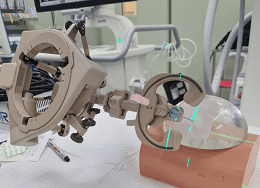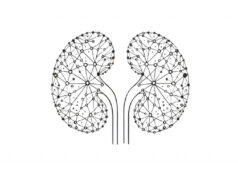
A research team led by Kazumi Taguchi, Shuzo Hamamoto and Takahiro Yasui (Nagoya City University [NCU], Nagoya, Japan) recently undertook a clinical trial to assess whether an artificial intelligence (AI)-powered device called the Automated Needle Targeting with X-ray (ANT-X) could offer improved precision in renal access for kidney stone surgery—and found the novel, robotic technology to be safe and convenient across a series of percutaneous nephrolithotomy (PCNL) procedures.
As per an NCU press release, PCNL represents an efficient, minimally invasive, gold-standard procedure for removing large kidney stones. Creating an access from the skin on the back to the kidney—called renal access—is a crucial yet challenging step in PCNL, and an inefficiently created renal access can lead to severe complications including massive bleeding, thoracis and bowel injuries, renal pelvis perforation, or even sepsis.
The two main renal access methods adopted during PCNL—fluoroscopic guidance, and ultrasound guidance with or without fluoroscopy—both deliver similar postoperative outcomes but require experience-based expertise. As such, numerous novel methods and technologies are being tested and used in clinical practice to help overcome this skill requirement. While some offer better imaging guidance, others provide precise percutaneous access. Nonetheless, most techniques are still challenging for beginners.
This led the NCU team to conduct a randomised, single-blind, controlled trial comparing their robotic-assisted fluoroscopic-guided (RAF) method with conventional, ultrasound-guided PCNL. In the trial, they assessed whether the ANT-X, which was developed by Singaporean medical start-up NDR Medical Technology, offers better precision in percutaneous renal access along with automated needle trajectory.
The results of this trial have been published in The Journal of Urology. The trial was conducted at NCU Hospital between January 2020 and May 2021 with 71 patients—36 in the RAF group and 35 in the ultrasound group. The primary outcome of the study was single-puncture success, with stone-free rate (SFR), complication rate, parameters measured during renal access, and fluoroscopy time, as secondary outcomes. “This was the first human study comparing RAF with conventional ultrasound guidance for renal access during PCNL, and the first clinical application of the ANT-X,” said Taguchi.
Regarding results, the single-puncture success rate was roughly 34% and 50% in the ultrasound and RAF groups, respectively. The average number of needle punctures were significantly fewer in the RAF group (1.82 times) as opposed to the ultrasound group (2.51 times), the researchers detail. In 14.3% of ultrasound-guided cases, the resident was unable to obtain renal access due to procedural difficulty and needed a surgeon change. However, none of the RAF cases faced this issue. In addition, the median needle puncture duration was also significantly shorter in the RAF group (5.5 minutes versus eight minutes in the ultrasound group). There were no significant differences in the other secondary outcomes. According to the researchers, these results revealed that using RAF guidance reduced the mean number of needle punctures by 0.73 times.
Multiple renal accesses during PCNL are directly linked to postoperative complications, including decreased renal function, the release notes. Therefore, the low needle puncture frequency and shorter puncture duration demonstrated by the ANT-X may provide better long-term outcomes for patients. And, while the actual PCNL was performed by residents in both groups, the renal access was created by a single novice surgeon using ANT-X in the RAF group. This demonstrates the safety and convenience of the novel robotic device, and the potential it holds in reducing surgeons’ training load and allowing more hospitals to offer PCNL procedures.
Outlining the potential advantages of the RAF device, Taguchi said: “The ANT-X simplifies a complex procedure, like PCNL, making it easier for more doctors to perform it and help more patients in the process. Being an AI-powered robotic technology, this technique may pave the way for automating similar interventional surgeries that could shorten the procedure time, relieve the burden on senior doctors, and perhaps reduce the occurrence of complications.”











